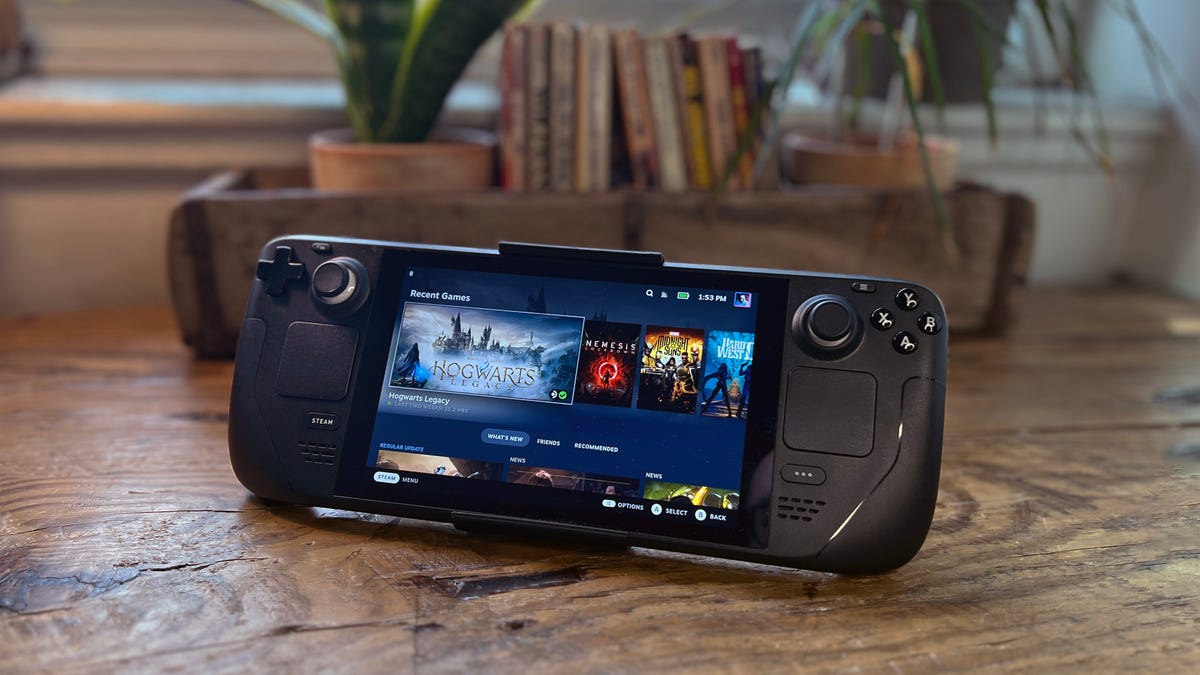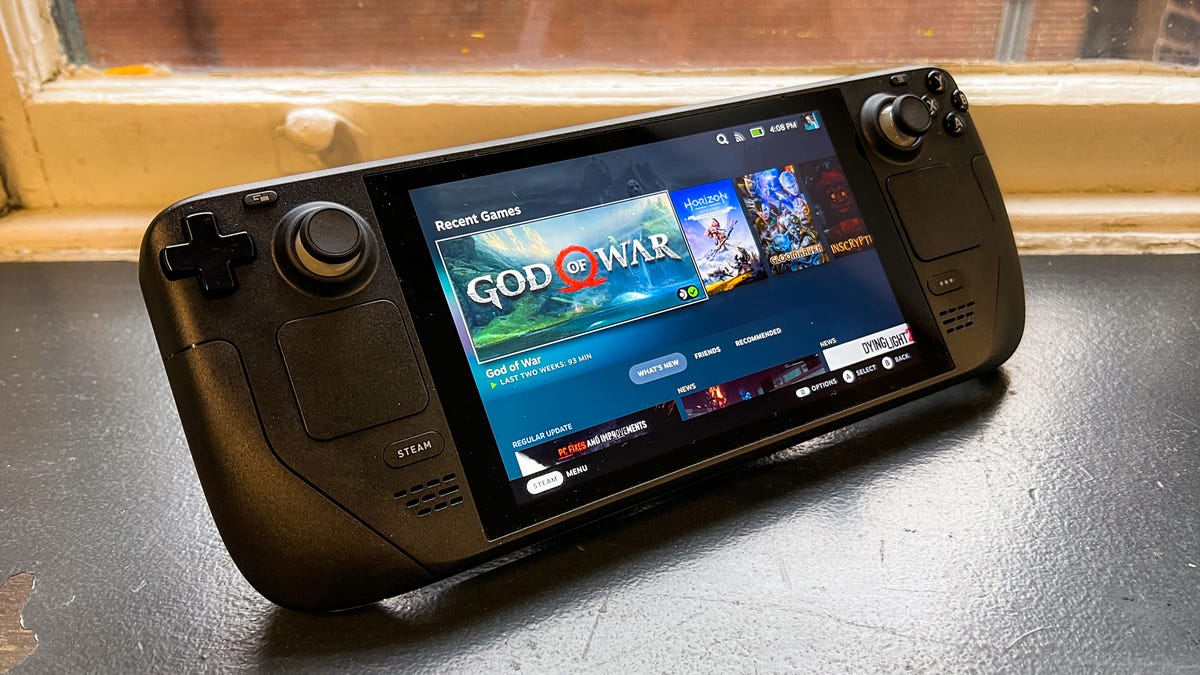Technologies
Steam Deck Has Evolved Into an Amazing Handheld Gaming Device
Thanks to a steady stream of software updates and strong support from game-makers, the Steam Deck has become a handheld gaming device worth buying.

Almost everything about the Steam Deck screams first-generation hardware. It’s a little awkward and clunky, sometimes even creaky. The screen has an oversized bezel that makes it feel small within the hulky body. The button layout isn’t especially ergonomic. And especially during its initial months, getting games to play on it sometimes required wrestling the system into submission, using updates, tweaks and hacks to get software running passably.
And yet, after my initial review, I came back to this handheld gaming PC from Valve, time and time again.
Originally, I said it was best for serious PC gamers who were used to the trial-and-error process of getting games to run on different types of computer hardware.
Now, after a year of steady feature updates to its SteamOS software and widely increased out-of-the-box support for major game releases, the Steam Deck is a much different animal. I’d say it’s good enough now that even gamers used to the plug-and-play ease of a Nintendo Switch could probably swing it.
Read more: Steam Deck Review: This Handheld Gaming PC Surprised Me, in Ways Both Good and Bad


Steady evolution
Since its initial release in February last year, the Steam Deck has upgraded or added functionality including better overall performance, smarter cooling and fan speed options, increased compatibility with a massive number of Steam games, better control and sorting of your game library, numerous UI improvements, midgame suspension for quick shutdowns, big improvements to control customization, and better support for expanded microSD storage.
Both Valve and other companies have expanded the Steam Deck’s capabilities through accessories, including docking stations for connecting the system to a TV or monitor and numerous skins, cases and kickstands.
The end result is that the Steam Deck feels like a reasonably polished PC gaming tool now, which is amazing considering it starts at $399 (£349), with two upgraded storage models at $529 and $649. Similar products like the new Razer Edge cost around the same but do less. A lot less.
Making the games the star
The actual hardware, frankly a bit on the underpowered side for a budget gaming PC, isn’t the big selling point. It’s the ability to play PC games, from big new releases to cult indie games, with the convenience of a handheld.
Recently, I’ve been playing Hogwarts Legacy on the Steam Deck, where it runs great (and better than a promised eventual Nintendo Switch version ever will) and Marvel’s Midnight Suns, which took a couple of months to get properly patched for Steam Deck. Games that have worked really well for me include Hard West 2, Uncharted: Legacy of Thieves Collection and Baldur’s Gate 3. Other games that are a natural for Steam Deck include Elden Ring, No Man’s Sky (despite a bug that wiped my saved progress), Vampire Survivors and The Witcher 3.
Valve has gotten better at figuring out which games will work well on the Steam Deck and making that information available to gamers, plus there’s a lot of community suggestions that go beyond the official «great for Steam Deck» tag.
More work to do
That doesn’t mean the Steam Deck is a flawless device. After all, there’s only so much you can do via software updates when the actual hardware is static. Battery life remains an issue — graphically intense games can run for maybe two hours before you need to plug in.
And not all Steam games run, or run well. You’ll often have to drop the graphics settings or compromise on frame rate to make a new game playable. In this area, the Steam Deck’s low screen resolution of 1,280×800 pixels is what allows for a lot of games to play well.
Playing via a TV or monitor through a dock or USB-C-to-HDMI cable isn’t ever going to be great, because often you’ll be playing at higher resolutions than the device can really drive, or else playing at a lower resolution than your 4K screen is capable of. In those cases, an Xbox or PS5 is going to give you a better overall experience.
Getting access to games outside of the Steam ecosystem, including cloud streaming games, remains a hassle — you have to install Microsoft Edge via the Linux-based desktop mode and do a bunch of extra setup from there. Same goes for adding games from other PC gaming storefronts like GOG and the Epic Game Store. Yes, this is a Steam-based product, but PC gamers expect to be able to play games from multiple sources, and they’re right to do so.
The biggest hurdle the Steam Deck faces is that its AMD CPU and GPU aren’t getting any younger, and more powerful components — along with design and ergonomic improvements, a better screen and improved battery life — are on everyone’s must-have list for a Steam Deck 2. There’s no real idea of when that might happen, but the Steam Deck is enough of a hit that a new version is almost guaranteed.
I don’t have any specific insight, but I suspect it’s at least a year or more away. So if you’re interested in buying a Steam Deck for around $500 — I recommend the middle model with 256GB and adding your own microSD card for additional storage — it’s a safe bet to invest now without too much upgrade anxiety.
Valve’s previous hardware initiatives, including the Steam Machine and Steam Controller, never really got out of the gate. With the Steam Deck, the company finally has a genuine hardware hit on its hands. Even better, for me (and I suspect a lot of other people) it has reinvigorated my appreciation for the wide world of PC gaming.
More on Steam Deck
- Steam Deck Review: This Handheld Gaming PC Surprised Me, in Ways Both Good and Bad
- Valve Steam Deck vs. Nintendo Switch OLED: Specs Compared
- Best Steam Deck Accessories in 2023
- The Steam Deck Really Needs a Kickstand, So I Made One
- Steam Deck Docking Stations: Valve vs. Jsaux
- Steam Deck Evolved: Valve’s Portable Gaming PC, One Year Later
Technologies
Today’s NYT Mini Crossword Answers for Tuesday, Oct. 14
Here are the answers for The New York Times Mini Crossword for Oct. 14.

Looking for the most recent Mini Crossword answer? Click here for today’s Mini Crossword hints, as well as our daily answers and hints for The New York Times Wordle, Strands, Connections and Connections: Sports Edition puzzles.
Today’s Mini Crossword has an odd vertical shape, with an extra Across clue, and only four Down clues. The clues are not terribly difficult, but one or two could be tricky. Read on if you need the answers. And if you could use some hints and guidance for daily solving, check out our Mini Crossword tips.
If you’re looking for today’s Wordle, Connections, Connections: Sports Edition and Strands answers, you can visit CNET’s NYT puzzle hints page.
Read more: Tips and Tricks for Solving The New York Times Mini Crossword
Let’s get to those Mini Crossword clues and answers.
Mini across clues and answers
1A clue: Smokes, informally
Answer: CIGS
5A clue: «Don’t have ___, man!» (Bart Simpson catchphrase)
Answer: ACOW
6A clue: What the vehicle in «lane one» of this crossword is winning?
Answer: RACE
7A clue: Pitt of Hollywood
Answer: BRAD
8A clue: «Yeah, whatever»
Answer: SURE
9A clue: Rd. crossers
Answer: STS
Mini down clues and answers
1D clue: Things to «load» before a marathon
Answer: CARBS
2D clue: Mythical figure who inspired the idiom «fly too close to the sun»
Answer: ICARUS
3D clue: Zoomer around a small track
Answer: GOCART
4D clue: Neighbors of Norwegians
Answer: SWEDES
Technologies
Watch SpaceX’s Starship Flight Test 11
Technologies
New California Law Wants Companion Chatbots to Tell Kids to Take Breaks
Gov. Gavin Newsom signed the new requirements on AI companions into law on Monday.

AI companion chatbots will have to remind users in California that they’re not human under a new law signed Monday by Gov. Gavin Newsom.
The law, SB 243, also requires companion chatbot companies to maintain protocols for identifying and addressing cases in which users express suicidal ideation or self-harm. For users under 18, chatbots will have to provide a notification at least every three hours that reminds users to take a break and that the bot is not human.
It’s one of several bills Newsom has signed in recent weeks dealing with social media, artificial intelligence and other consumer technology issues. Another bill signed Monday, AB 56, requires warning labels on social media platforms, similar to those required for tobacco products. Last week, Newsom signed measures requiring internet browsers to make it easy for people to tell websites they don’t want them to sell their data and banning loud advertisements on streaming platforms.
AI companion chatbots have drawn particular scrutiny from lawmakers and regulators in recent months. The Federal Trade Commission launched an investigation into several companies in response to complaints by consumer groups and parents that the bots were harming children’s mental health. OpenAI introduced new parental controls and other guardrails in its popular ChatGPT platform after the company was sued by parents who allege ChatGPT contributed to their teen son’s suicide.
«We’ve seen some truly horrific and tragic examples of young people harmed by unregulated tech, and we won’t stand by while companies continue without necessary limits and accountability,» Newsom said in a statement.
Don’t miss any of our unbiased tech content and lab-based reviews. Add CNET as a preferred Google source.
One AI companion developer, Replika, told CNET that it already has protocols to detect self-harm as required by the new law, and that it is working with regulators and others to comply with requirements and protect consumers.
«As one of the pioneers in AI companionship, we recognize our profound responsibility to lead on safety,» Replika’s Minju Song said in an emailed statement. Song said Replika uses content-filtering systems, community guidelines and safety systems that refer users to crisis resources when needed.
Read more: Using AI as a Therapist? Why Professionals Say You Should Think Again
A Character.ai spokesperson said the company «welcomes working with regulators and lawmakers as they develop regulations and legislation for this emerging space, and will comply with laws, including SB 243.» OpenAI spokesperson Jamie Radice called the bill a «meaningful move forward» for AI safety. «By setting clear guardrails, California is helping shape a more responsible approach to AI development and deployment across the country,» Radice said in an email.
One bill Newsom has yet to sign, AB 1064, would go further by prohibiting developers from making companion chatbots available to children unless the AI companion is «not foreseeably capable of» encouraging harmful activities or engaging in sexually explicit interactions, among other things.
-

 Technologies3 года ago
Technologies3 года agoTech Companies Need to Be Held Accountable for Security, Experts Say
-

 Technologies3 года ago
Technologies3 года agoBest Handheld Game Console in 2023
-

 Technologies3 года ago
Technologies3 года agoTighten Up Your VR Game With the Best Head Straps for Quest 2
-

 Technologies4 года ago
Technologies4 года agoVerum, Wickr and Threema: next generation secured messengers
-

 Technologies4 года ago
Technologies4 года agoGoogle to require vaccinations as Silicon Valley rethinks return-to-office policies
-

 Technologies4 года ago
Technologies4 года agoBlack Friday 2021: The best deals on TVs, headphones, kitchenware, and more
-

 Technologies4 года ago
Technologies4 года agoOlivia Harlan Dekker for Verum Messenger
-

 Technologies4 года ago
Technologies4 года agoiPhone 13 event: How to watch Apple’s big announcement tomorrow

